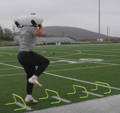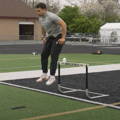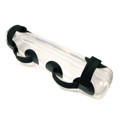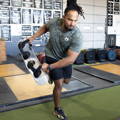Plyo Workout for D1 Athletes
FREE SPEED & POWER WORKOUT!
Download by entering below

Best Drills To Improve Max Speed
Thinking about speed, we have to look at it as simply as possible. One advantage I have in not being the brightest individual is that I need to spend that extra time to have some translation when reading all the research to make things understandable. The research gets confusing. For instance, I wasn’t good at physics growing up so F=MA wasn’t my jam. But as an adult, I know Force equals Mass times Acceleration, and is a great way to think about sprinting.
See, with sprinting, every time an athlete puts action into the planet the body the planet gives a reaction back, which can be equal to mass times acceleration. Let’s look at this as the idea of IMPULSE. Impulse is the amount of force that can put, in this case, into the ground over a while. A lot of people will focus on the peak force, but in reality, peak force doesn’t necessarily matter as the overall force over time. For instance, if we have an athlete who puts a very large amount of force into the ground for a short time relative to the task, the athlete will not have as big of an impulse and therefore won’t be able to cover as much ground as a person who can put more force or the same amount of force for a longer period.
Talking about sprinting and mechanics around running, that window of time is super short. However, if we can improve grounding mechanics with mechanics and drills, the body can put more force during that short period for the longer time the impulse force is being applied.
Let’s look at some drills that feed into developing athletes’ abilities to create a greater impulse to be faster on their feet.
1. Hydro Bag Switches
Back racking a hydro bag does work for dynamic trunk control. Using mini-hurdles and touching down with a near flat foot for essentially two steps between hurdles while the non-grounding leg hits and holds a hip lock creates this 90/90 angle. The whole goal of this drill is to not quite go flat-footed, around 10 degrees, and stay upright to be able to put more force into the ground. It all goes back to ground force application. The movement helps with peak speed by developing maximal mechanics.
This is a very challenging movement, especially with the hydro weight. Some athletes may do three steps between hurdles and then switch legs. Ideally, we want to see athletes hit two steps. In addition, if we look at the foot almost going flat foot grounding, definitely dorsiflexed, that is lengthening the window to apply a lot of force. Running at top speed and making that window slightly longer will lead to a greater impulse which leads to greater force into the ground which will lead to faster times down the track, on the field, and in competitive play.

Ideally, the movement is “1-2 switch, 1-2 switch.” The other aspect of this movement is what is being done with the hip. Focusing on the hip control via the hip lock will help develop acceleration from the blocks through the hip co-contraction. The hip lock will help the driving the knees to lengthen the stride in the first, and maybe most important, three strides in sprinting and acceleration.
Everyone knows Garage Strength always talks about dynamic trunk control (DTC). Athletes who are stable and upright, especially at max speed, will have more energy going back into the ground and will have that energy coming back at them. Action equals reaction! Force equals mass times acceleration! The beauty of the hydro weight is that it forces the trunk to stay stable and upright to develop the force application even more.
This movement can be done as a warm-up, but I also believe it can be done for 10 to 12 reps through 5 mini-hurdles.

2. Skips For Distance
I like to establish a distance that can be consistent. I like to start at a 20-yard distance to begin. The goal is for the athlete to establish how many skips it takes to cover that initial 20 yards. As we progress through 4 to 5 sets, we want to see that the number of steps to cover the 20 yards decreases. The decrease in skips means that greater force is being applied to the ground and indicates that the athlete is becoming faster because the stretch-shortening cycle is becoming more potent.
Sometimes, athletes run into neural body blocks. Athletes will struggle to execute the skips like an athlete. They may forget to switch to the other leg during the skips. They may struggle to connect the skips for distance. We talk a lot about central pattern generators. When something rhythmic is being asked to be performed, the CPGs take over. Athletes need to do a couple of sets with shorter skips to develop the patterning and rhythm to execute the movement. Think of it as switching time signatures in a musical piece. The task on the neural input for the desired output is demanding.
The point of skipping for distance is to teach the body how to apply a large amount of force. Use the eye test to count the number of skips to reach and surpass the established distance. We want to see the athletes project themselves forward. That goes back to stride length and stride frequency. The angle of take-off impacts the length of stride and the amount of time in the air. A longer stride and stride frequency plays a major role in an athlete’s sprint speed.
3. Single Leg Bounds
Once again we want to establish a distance. I like 30 yards. The athlete will bound from leg to leg, alternating the leg in the air. Remember, an impulse is the amount of force that is applied over some time. Single leg bounds as a skill are great to learn to teach the body to apply a ton of force. Being done over a specific distance, ideally, we will see the athlete execute fewer strides as they work through multiple sets of the exercise. The losing of a stride is a clear indicator of the athlete applying a greater amount of force over a greater time through the bounds.
I recommend trying to focus on bounding high while still having a major focus on projecting the body forward in a horizontal trajectory. Keep driving the knee up and high, staying tall, and projecting the body forward. As we think of force application into the ground, it comes back to stride length and stride frequency; the angle the athlete projects themself from all contributes to the equation of stride length and stride frequency.
Quick tip for coaches and athletes, pay attention to athletes and how they may favor one side over the other. Looking at this information, we can then have the athlete in the weight room focus on the weak leg first when performing unilateral work like single-leg squats.

4. Hurdle Hop To Double Leg Bound
We want athletes to improve their ability to master the stretch-shortening cycle. That is where the hurdle hop to double leg bounds comes into play. Again, I like to use a specific distance. In this case, 10 yards works. The specific distance is used to see how the athlete improves their ability to apply force. And that is the whole goal! Every session that is focused on speed has to revolve around improving impulse. That means we want to lengthen that window of ground contact ever so slightly and also enhance the amount of force being applied to the ground for that time. A specific distance just through an eye test allows a coach to easily see how the impulse equation is being impacted. Not everyone has access to force plates.

More advanced athletes may clear the 10-yard marker in three bounds. The eye test then requires looking at how much farther past the 10-yard mark the athlete lands on that final bound. Marking that area can function as a carrot for the athlete to reach for to keep showcasing their improvement.
Remember, we want the athlete to improve their skill of executing the stretch-shortening cycle which will help increase the athlete’s speed.

Recap
All of the aforementioned exercises and drills lead to improvements in athletes’ impulse-producing skills. Improving an athlete’s overall impulse has a massive impact on moving the body. Use all the drills to improve max speed, enhance the ability to execute the stretch-shortening cycles, and simply be faster.
Related Posts
Blog Topics

Yo, It's Dane
Welcome to the Garage Strength Blog, where it is my goal to provide you with the experience and knowledge I've gained in the strength and conditioning world over many years of learning from both successes and failures. I train elite-level athletes in a multitude of sports from the high school to professional levels, already producing 5 Olympics and 30+ National Champions. If you want to be the next champion I train, check out my strength programs below!
Start Training With Me

Join for free educational videos EVERY WEEK on strength coaching and athletic performance





